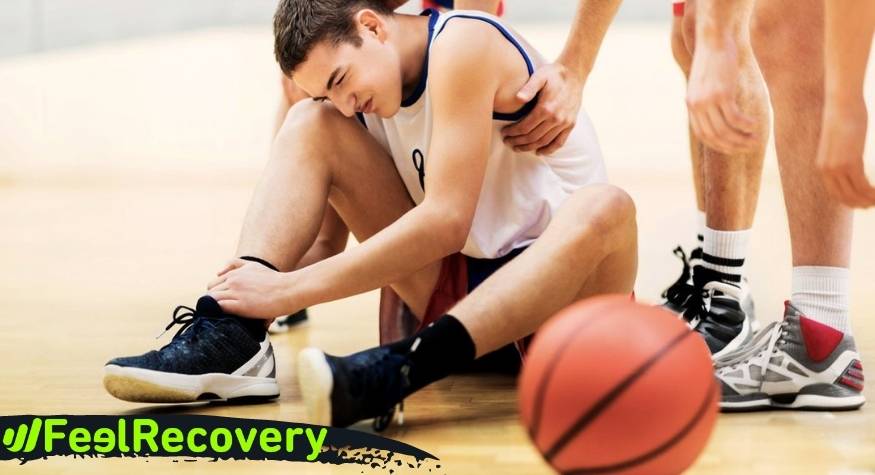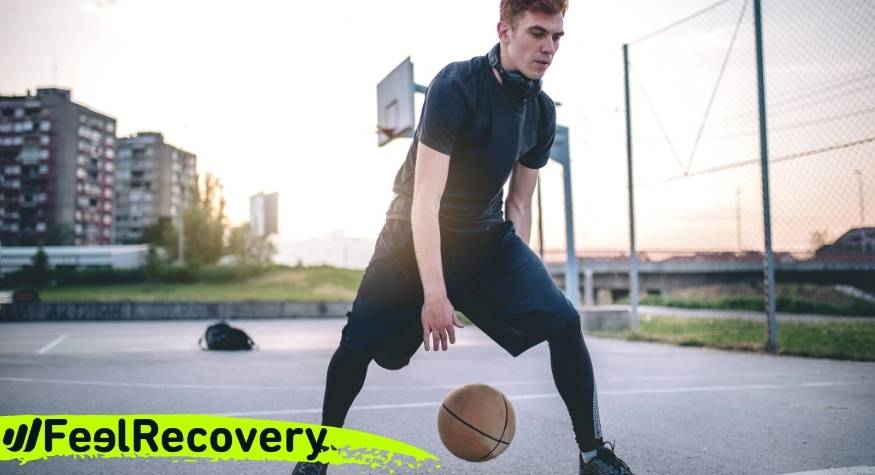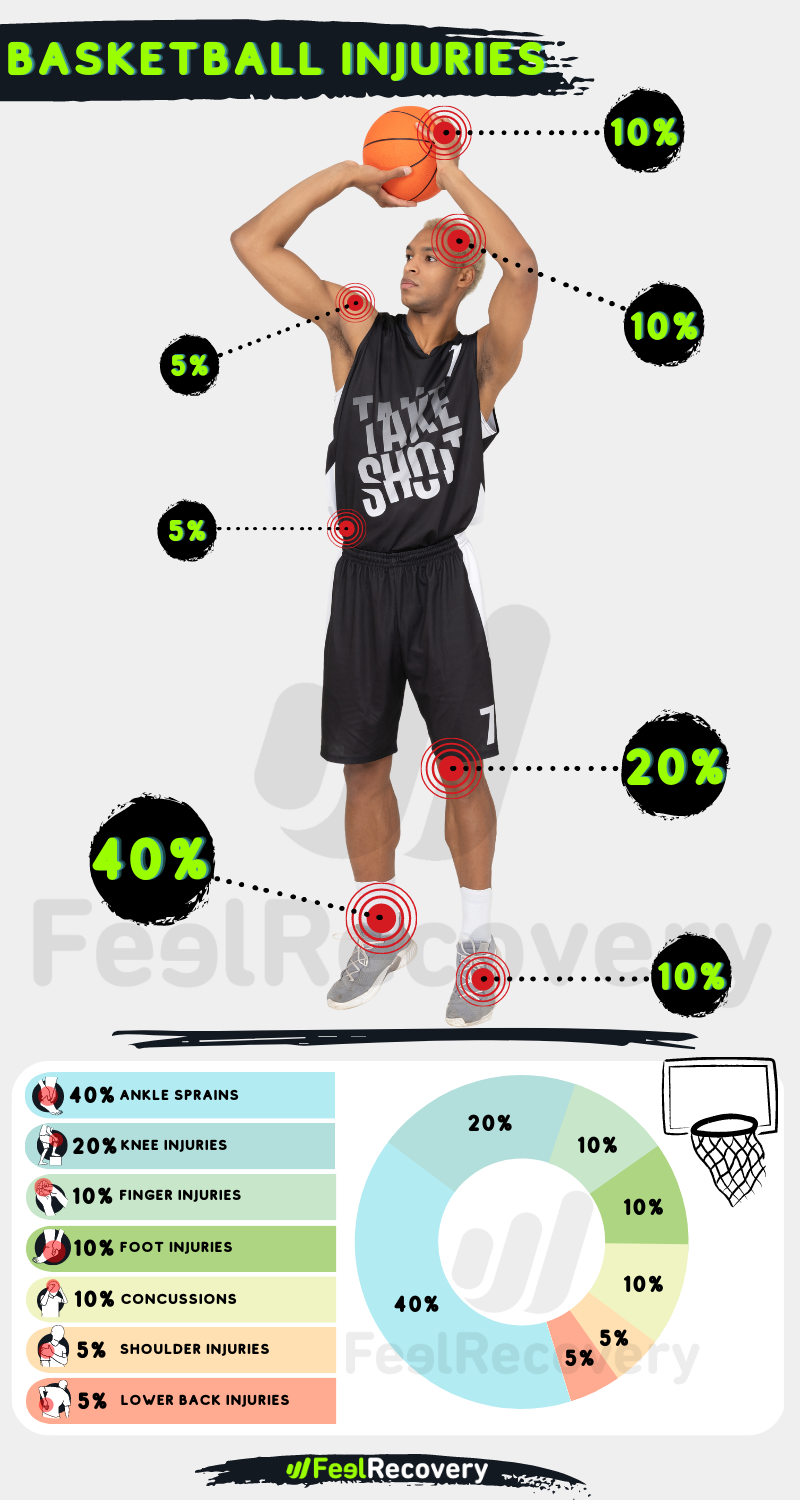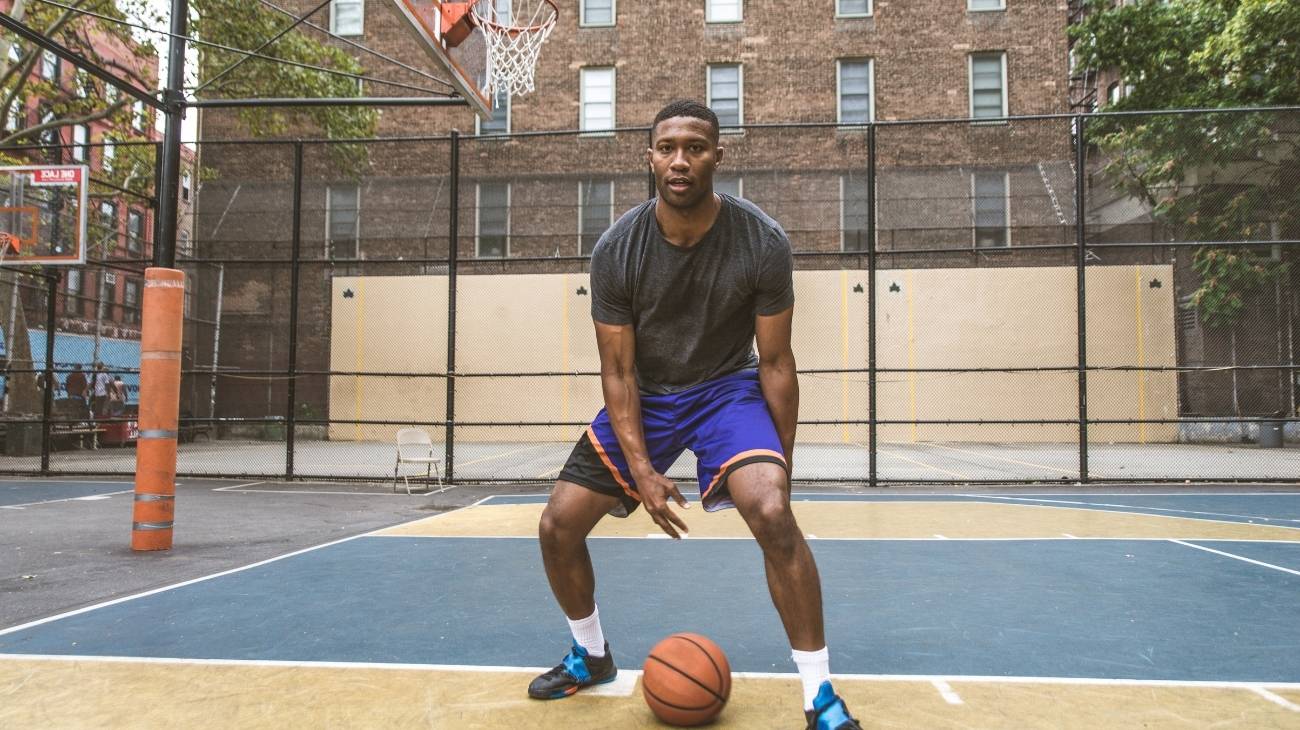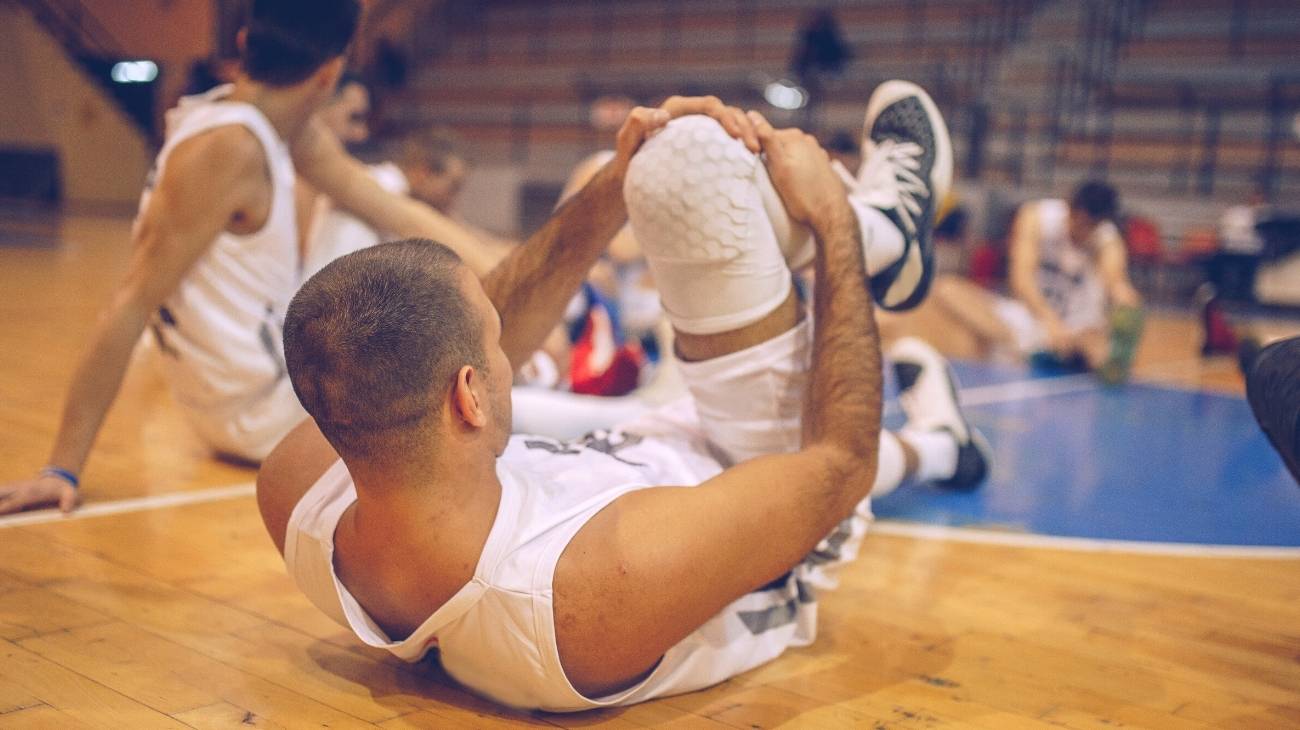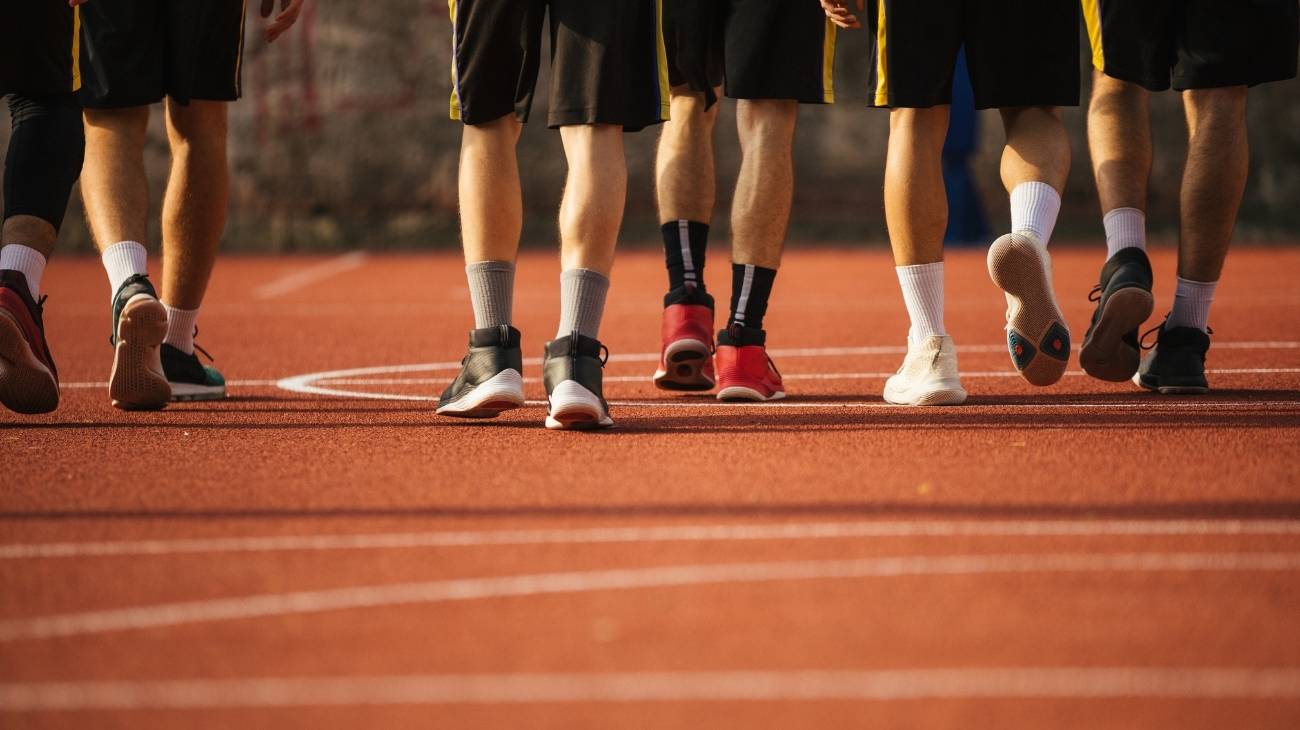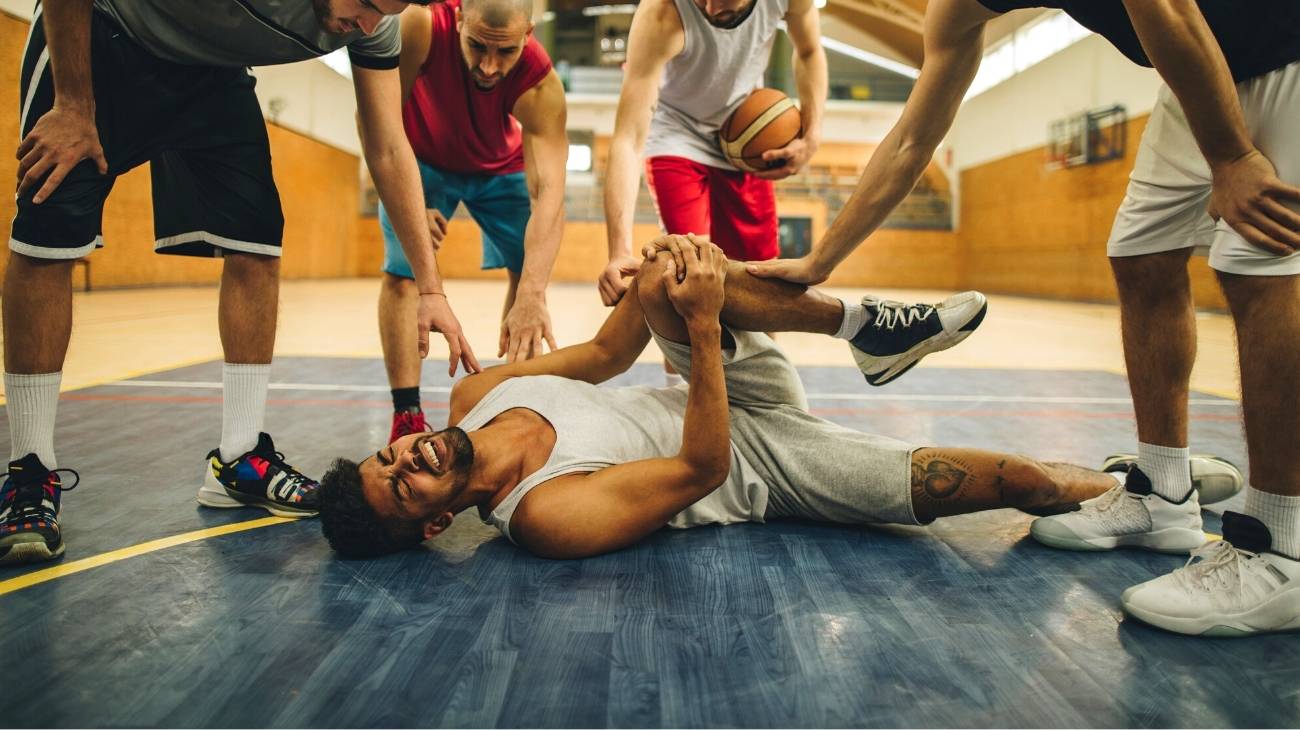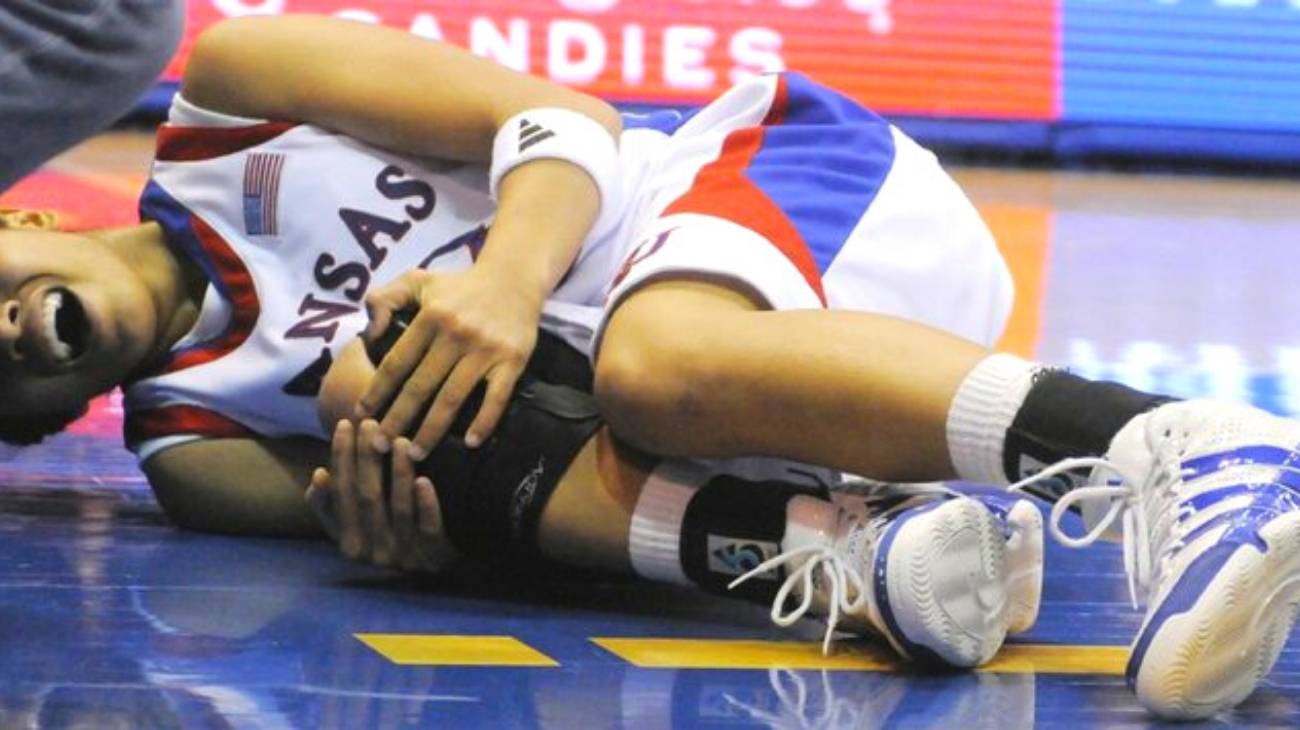The word injury is the word any sportsman or sportswoman, even basketball players, least wants to hear. The possibility of having to be out of action for weeks or even months at a time is something that no one, professional or amateur, is happy about.
Find out which injuries are the most common in training or on the court and which product is the most recommended to accompany your preferred method of prevention. This is a total guide for the basketball professional.
What are the most common types of injuries when playing basketball?
It has been proven that most basketball injuries occur in the shoulders, elbows, wrists, fingers, knees and ankles. As no professional player is exempt from being injured due to a bone, muscle or ligament problem, we invite you to learn about the most common injuries:
- Ankle sprains: The result of an unnatural movement of the ankle that causes the ligaments to overstretch and suffer damage that can range from mild swelling to complete loosening of the ankle. It is common to see these injuries in players who land with their foot in the wrong position after a jump shot to score or block an opponent.
- Toe sprain: Usually occurs when the ball touches the toes at high speed. This heavy contact causes significant swelling of a single joint. When pain and swelling persist, it is best to stop physical activity as the damage can be such that the metatarsal of the toe involved is fractured.
- Knee injuries: As players require sudden movements, in any direction, the knee also bears the full weight of the body and is often worn down to injury. Cutting manoeuvres, which involve braking and starting, put significant wear and tear on the ligaments and meniscus of the knee. The most common injury is to the medial collateral ligament, which comes after constant blows to the outside of the joint, but anything from sprains to complete ligament tears can also occur and will almost certainly require surgery.
- Muscle trauma: This is nothing more than a blow to a muscle. Being a contact sport, it is normal for there to be hard knocks. Although in more than 80% of cases it is nothing more than a simple contusion, if you are not in good shape it can lead to a muscle fracture, which occurs when part of the muscle tissue is torn.
- Stress fracture: Although it may seem exaggerated, the body also suffers from stress due to overtraining or over-matching. A rapid and constant increase in activity increases the risk of fractures in both the upper and lower extremities. The tibia is often the bone most prone to fracture in basketball.
- Cuts to the skin: Cuts are caused by accidental hard knocks with other players or sharp falls during training and games. Perhaps an elbow, punch or head-on collision of the face with the shoulder of another basketball player has caused the skin to crack. Such a cut may require stitches that can be done instantly and close the wound in time before further bleeding occurs. It usually does not require stopping physical activity.
Best products for basketball injury recovery
Bestseller
-
2 Ankle Compression Sleeve (Green/Navy)
£20,95 -
2 Calf Compression Sleeve (Black/Gray)
£20,95 -
2 Calf Compression Sleeve (Green/Navy)
£20,95 -
2 Calf Compression Sleeve (Pink/Bordeaux)
£20,95 -
2 Elbow Compression Sleeve (Black/Gray)
£20,95 -
2 Elbow Compression Sleeve (Green/Navy)
£20,95 -
2 Elbow Compression Sleeve (Pink/Bordeaux)
£20,95 -
2 Knee Compression Sleeve (Black/Gray)
£20,95 -
2 Knee Compression Sleeve (Green/Navy)
£20,95 -
2 Knee Compression Sleeve (Pink/Bordeaux)
£20,95 -
2 Thigh Compression Sleeve (Black/Gray)
£20,95 -
2 Thigh Compression Sleeve (Green/Navy)
£20,95 -
2 Thigh Compression Sleeve (Pink/Bordeaux)
£20,95 -
Microwaveable Wheat Bag for Pain Relief (Hearts)
£20,95 -
Microwaveable Wheat Bag for Pain Relief (Oxford)
£20,95 -
Microwaveable Wheat Bag for Pain Relief (Sport)
£20,95
-
2 Ankle Compression Sleeve (Black/Gray)
£20,95 -
2 Ankle Compression Sleeve (Pink/Bordeaux)
£20,95 -
2 Patella Knee Strap (Black/Gray)
£12,95 -
2 Patella Knee Strap (Green/Navy)
£12,95 -
2 Patella Knee Strap (Pink/Bordeaux)
£12,95 -
Foot Massage Roller for Plantar Fasciitis (Black)
£20,95 -
Foot Massage Roller for Plantar Fasciitis (Green)
£20,95 -
Foot Massage Roller for Plantar Fasciitis (Pink)
£20,95 -
Ice Massage Roller Ball (Black)
£34,95 -
Ice Massage Roller Ball (Green)
£34,95 -
Ice Massage Roller Ball (Pink)
£34,95 -
Shoulder Support Brace (Black)
£24,95 -
Shoulder Support Brace (Green)
£24,95 -
Shoulder Support Brace (Pink)
£24,95 -
Soft Density Foam Roller for Recovery (Black)
£34,95 -
Soft Density Foam Roller for Recovery (Green)
£34,95 -
Soft Density Foam Roller for Recovery (Pink)
£34,95 -
Sport Compression Socks (1 Pair) (Black/Gray)
£20,95 -
Sport Compression Socks (1 Pair) (Green/Navy)
£20,95 -
Sport Compression Socks (1 Pair) (Pink/Bordeaux)
£20,95
List of injury prevention methods in basketball
As the idea is to get on with the training and the games, we leave you with a series of injury prevention methods that are quite useful when playing basketball. To become as great as Michael Jordan or Pau Gasol, you must stay active at all times and you will achieve this with these recommendations:
Warm up
This is almost an obligation before any sporting activity, be it training or a professional game. If you play basketball for recreation, it is even more important to warm up your body because you are not used to this physical activity.
How to start? With a ball and walking with it all over the court, thus activating muscle memory in vital parts of your body such as shoulders, wrists, knee and ankle. Not to mention stretching every joint and part of your musculature so that your muscle fibres are ready to receive that increased blood flow when you start playing or training.
Finish your workouts with a cool down
Getting back to a calm state after a workout is also important for your body. It's like if you try to stop running to be still. What does your body feel in that case? A shock, which will not only negatively affect your cardiac system, but will also make your muscles more fragile and more susceptible to injury.
That's why professionals perform stretching sessions at the end of an intense workout or match, so that the muscles relax before going into a resting state. It's also a good idea to keep walking for a few minutes before sitting down, so that your cardiac system doesn't suffer from stopping suddenly.
Good nutrition and hydration
Believe it or not, a basketball player needs five meals a day, following a strict diet that allows your body to get the nutrients it needs. Carbohydrates are indispensable in his diet: cereals, rice, oatmeal, quinoa, bread and pasta, as well as vegetables should also be in his diet. On match day, the last meal should be eaten two to three hours before a match.
As for hydration, it is also part of training. Cramps, muscle exhaustion and difficulties in movement are the result of a body that is not well hydrated for sporting activity. Therefore, when training or during a match, water or hydration drinks with a considerable electrolyte load should be consumed constantly.
Improve your physical condition
Basketball is a sport of strength and endurance, so training should encompass both demands. It is important to have intense training sessions so that you can cope with all the demands of a game, but do not overdo it as you risk over-fatiguing your muscles.
If we are amateurs, jogging two or three times a week for 30 to 40 minutes should be enough to get us through a few matches every afternoon on the local pitch. But if we want to dedicate ourselves to this professionally, we will have to follow the instructions of our physical trainer to the letter in order to gain the aerobic and anaerobic endurance we need.
Sports massage
What is the purpose of these? To prevent injuries and even recover from them. Not just anyone can massage an athlete, it must be a specialist as there is a risk of damage to the patient's muscle tissue. A good massage prepares the athlete for the sporting activity and helps the body to recover after an exhausting day.
Each massage varies according to the intention of the massage, but in essence the most commonly used techniques are; stretching or rubbing, kneading, articulations, passive movements and percussions. Choosing the most appropriate one for you should always be the decision of an expert physiotherapist.
Use of heat and cold therapies
The application of heat or cold to parts of the body serves a variety of purposes. For example, heat is useful to combat stiffness in the joints. It can be a warm bath, electric blankets, warm compresses, whatever the sports physician prescribes. In turn, cold helps to reduce swelling, aches and pains and musical spasms.
Both are considered in most cases as first aid methods, as more specialised strategies such as cryotherapy and thermotherapy are often used in cases of recovery from more serious injuries.
Use of compression garments
The use of compression garments began more than 50 years ago and has been used in sports medicine since the 1990s. These garments enhance performance in running or fast movements. This is because they improve venous return and oxygen supply to the muscles, and the garments are proven to reduce muscle fatigue. The most common garments worn by basketball players during games are compression sleeves for the hands and compression sleeves or compression stockings for the legs.
Use of acupressure therapies
Acupressure is based on applying pressure to specific points on the body that are connected to the nervous system, so that the accumulated tension in these points is reduced. While it uses the same principles and pressure points as acupuncture, it does not use needles but the fingertips to do the work. This practice is proven to reduce muscle fatigue and stress on the muscles, making them stronger and preventing injury.
Use of thermotherapy and cryotherapy
Thermotherapy uses heat as the main resource and there are a variety of ways to apply it. As each patient has different needs and resistances, it is up to the therapist to choose where to start and how to initiate the therapy. Cryotherapy, in turn, reduces the body's core temperature with techniques that lower blood flow, tissue metabolism and inflammation.
Use of good equipment
The most important thing is that the clothing should be light, remembering that players make quick and precise movements. The most important thing is the footwear, as it depends on effective movements and no possibility of slipping and getting injured. Shoes should have high boots to reduce the risk of sprains. The player should wear sleeveless shirts, shorts and socks or wrist sleeves that absorb as much sweat as possible.
References
- Harmer, P. A. (2005). Basketball injuries. Epidemiology of pediatric sports injuries: Team sports, 49, 31-61. https://www.karger.com/Article/Abstract/85341
- Newman, J. S., & Newberg, A. H. (2010). Basketball injuries. Radiologic Clinics, 48(6), 1095-1111. https://www.radiologic.theclinics.com/article/S0033-8389(10)00121-1/fulltext
- Trojian, T. H., Cracco, A., Hall, M., Mascaro, M., Aerni, G., & Ragle, R. (2013). Basketball injuries: caring for a basketball team. Current sports medicine reports, 12(5), 321-328. https://journals.lww.com/acsm-csmr/Fulltext/2013/09000/Basketball_Injuries___Caring_for_a_Basketball.13.aspx
- Borowski, L. A., Yard, E. E., Fields, S. K., & Comstock, R. D. (2008). The epidemiology of US high school basketball injuries, 2005–2007. The American journal of sports medicine, 36(12), 2328-2335. https://journals.sagepub.com/doi/abs/10.1177/0363546508322893
- Zelisko, J. A., Noble, H. B., & Porter, M. (1982). A comparison of men's and women's professional basketball injuries. The American journal of sports medicine, 10(5), 297-299. https://journals.sagepub.com/doi/abs/10.1177/036354658201000507
- Dick, R., Hertel, J., Agel, J., Grossman, J., & Marshall, S. W. (2007). Descriptive epidemiology of collegiate men's basketball injuries: National Collegiate Athletic Association Injury Surveillance System, 1988–1989 through 2003–2004. Journal of athletic training, 42(2), 194. https://www.ncbi.nlm.nih.gov/pmc/articles/PMC1941286/
- Bolotin, A., & Bakayev, V. (2016). Efficacy of using isometric exercises to prevent basketball injuries. Journal of Physical Education and Sport, 16(4), 1177. http://efsupit.ro/images/stories/nr4.2016/art188.pdf
- Padua, E., D’Amico, A. G., Alashram, A., Campoli, F., Romagnoli, C., Lombardo, M., ... & Annino, G. (2019). Effectiveness of warm-up routine on the ankle injuries prevention in young female basketball players: a randomized controlled trial. Medicina, 55(10), 690. https://www.mdpi.com/1648-9144/55/10/690
- Sonzogni Jr, J. J., & Gross, M. L. (1993). Assessment and treatment of basketball injuries. Clinics in sports medicine, 12(2), 221-237. https://europepmc.org/article/med/8481963
- McKay, G. D., Goldie, P. A., Payne, W. R., Oakes, B. W., & Watson, L. F. (2001). A prospective study of injuries in basketball: a total profile and comparison by gender and standard of competition. Journal of Science and Medicine in Sport, 4(2), 196-211. https://www.sciencedirect.com/science/article/abs/pii/S144024400180030X

